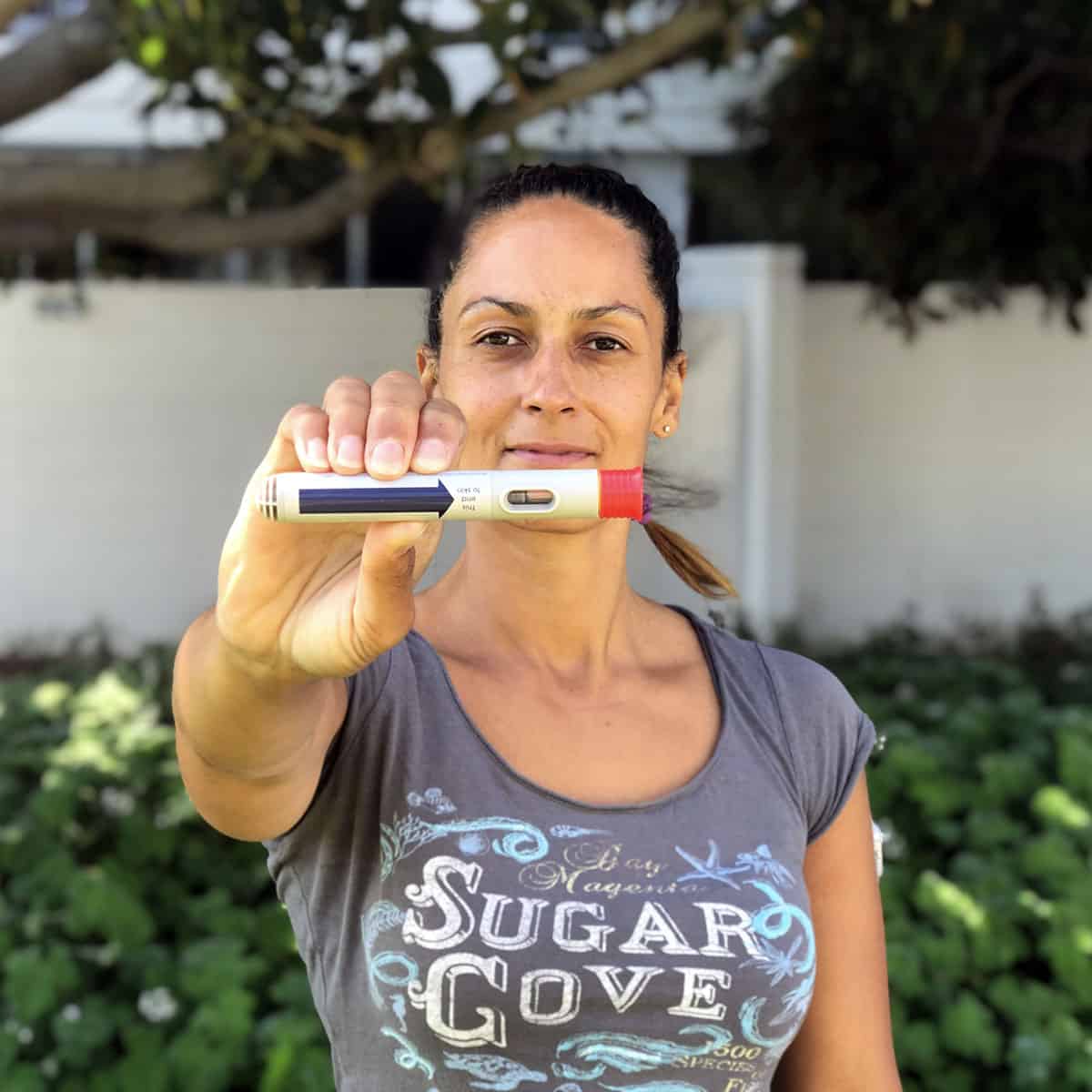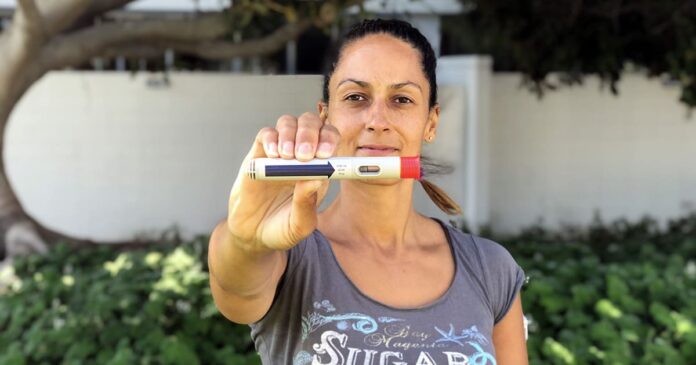Anyone who uses insulin to manage their diabetes is at risk of experiencing hypoglycemia, which means low blood sugar.
Most low blood sugars can be managed by eating or drinking carbohydrates, but some can be so severe that you need assistance to treat them and get your blood sugars back in range. Those episodes are defined as severe hypoglycemia or severe low blood sugar.
Severe low blood sugar is serious and can happen when you least expect it, which makes it imperative that you are prepared and that those around you know what action to take.
I’ve discussed hypoglycemia in detail before, as well as how to use GvokeTM premixed glucagon products to bring your blood sugars back to a safe range. What has happened since the last time we discussed Gvoke is that the auto-injector, Gvoke HypoPenTM (glucagon injection), is now available.
This is very exciting because we now have another easy way to administer glucagon. Like the prefilled syringe (Gvoke PFS), Gvoke HypoPen is a premixed and prefilled product, but with Gvoke HypoPen, you (or the person administering the product) will never see the needle and the administration process is very intuitive.
But although I’ve talked about severe low blood sugar before and how to treat it I don’t think we talk enough about severe low blood sugar.
Maybe you have never experienced a severe low blood sugar or maybe you’ve had a few. Regardless, talking about severe hypoglycemia could help demystify it, reduce the shame that some people feel about severe hypos, and start the dialog on how we can make sure that if one happens to us, it’s tackled appropriately.

This post is sponsored by Xeris Pharmaceuticals, Inc. the manufacturer of Gvoke
A real story of severe hypoglycemia
In late May of 2020, I had the chance to talk to a member of the Diabetes Strong Facebook community about her experience with severe low blood sugar.
With this story, we want to show that severe low blood sugars can happen to anyone, usually at inconvenient times, and how important it is that those around us know how to act and have the right tools available in the case of severe hypoglycemia.
This is Katie’s story.
Katie Reno was diagnosed with type 1 diabetes 31 years ago (January 1989) when she was 8 years old. She has been managing her diabetes using an insulin pump for many years and in recent years added a continuous glucose monitor (CGM) to her diabetes toolbox.
Katie grew up in South Dakota and lives in Huron with her husband, Jared, and her two teenagers Jackson and Jillian. She took up Crossfit 2 years ago and is now a Crossfit Level 1 trainer and the healthiest she’s ever been.
The whole family is involved in Katie’s diabetes management and she describes how she has glucose tablets stashed on every floor in her tall brick house.


Severe low blood sugar on vacation
Katie and Jared travel to Cabo, Mexico annually to vacation at a resort by the beach. On this particular day in the spring of 2018, they had been lounging by the pool and relaxing all day and were getting ready to go for dinner at one of their favorite restaurants on the resort.
It was a special evening so Katie dressed up. She didn’t want to bring a purse with her to dinner so she left her diabetes gear behind in the room. She knew the menu at the restaurant where they had reservations, what she’d wanted to eat, and how long it would take to get there, so she decided to pre-bolus and injected her insulin before they left the room (about 6-8 units of rapid-acting insulin).
On the way to the restaurant, they bumped into Bruce Johnston (a member of the Beach Boys) at the lounge and of course couldn’t pass up the chance to chat for a while. Katie enjoyed a few appetizers at the lounge and didn’t think much of it. They had been at the lounge for about an hour before leaving for the restaurant and that’s when Jared noticed that something was wrong.
Katie was now having a hard time walking (and she had not been drinking) and she collapsed and started to fade in and out of consciousness. The resort staff offered to send for medical help but they were very close to their room, and with another couple, so Jared ran to the room and got her some glucose tablets. But it wasn’t enough and her blood sugar meter just read “LOW”.
Katie was wheeled to her room in a wheelchair and Jared gave her a glucagon shot and waited for her to get back to her full cognitive self.
He continued to make her eat and her blood sugars came up and topped off around 250-300 mg/dl (14-18 mmol/L) and at this point, she felt crappy but she was fully conscious and alert. It took several hours to balance out her blood sugar and since this was before she got her CGM, she would measure her blood sugar every hour.
The emotional impact of a severe low blood sugar
Katie told me that while Jared kept his cool through the whole experience, he felt scared and worried. The worst part for him was waiting for her blood sugars to rise as his mind started to run through all the horrible “what if” scenarios in his head.
Katie on the other hand felt guilt. Guilt for being the center of a situation and shameful for “causing a scene”. Fortunately, they have a strong relationship and have worked through those feelings together by not trying to suppress them, but talking it out.
Other episodes
In the past, Katie has had glucagon used on her every 3-5 years, but since that severe low in Cabo, Katie’s blood sugar hasn’t been so low that she needed glucagon to raise it back to normal levels.
Another scary episode was 5-6 years ago while she was driving her daughter to dance recitals. She managed to pull over the car and was fortunate that a police car pulled up next to her and her daughter could explain the situation. That time an ambulance was called and they brought her blood sugar back up.
What Katie would like you to know about severe lows
For the longest time, Katie thought it was just her, that she was a bad diabetic and the only one who experienced severe low blood sugars. She now realizes that this is not the case and that was the reason she wanted to share her story.
You can do everything right or have the best of intentions and things can still go wrong.
Her key takeaway is to always be prepared, always have a backup plan, and listen to your body and learn the signals it’s sending you. She now has glucose tablets in all her purses, on every floor of her house, and in the car. When they travel, Jared has a glucagon kit in his bag. At home, it’s in his drawer.
Being prepared for a severe low blood sugar
I appreciate Katie showing her vulnerability and being willing to share her story with us as I think it highlights the importance of talking about severe lows and of taking the proper precaution when you live with insulin-dependent diabetes.
My takeaways, both from living with diabetes and discussing severe low blood sugar situations with others, are that a few but very important steps can help keep you safe.
- Measure your blood sugars often, and take immediate appropriate situational action
- Always carry fast-acting glucose such as glucose tablets or juice
- Always have a glucagon product, such as Gvoke HypoPen TM, and know how and when to use it
Even if you have never used glucagon, remember that if you are ever in a situation where you need it, not having filled the prescription won’t do you any good.
How to get Gvoke TM
After you have discussed glucagon with your doctor and learned how and when to use it, you’ll need to pick up your prescription at the pharmacy or online home delivery fulfilled by PillPack, an Amazon Company. (If you’d like it delivered to your home, information is available at GvokeGlucagon.com).
Visit GvokeGlucagon.com and learn more about a limited time $0 copay offering for commercially eligible patients.
Important Safety Information
Gvoke is a prescription medicine used to treat very low blood sugar (severe hypoglycemia) in adults and kids with diabetes ages 2 year and above. It is not known if Gvoke is safe and effective in children under 2 years of age.
Do not use Gvoke if you have a tumor in the gland on top of your kidneys (adrenal gland), called a pheochromocytoma; you have a tumor in your pancreas, called either insulinoma or glucagonoma; you are allergic to glucagon or any other inactive ingredient in Gvoke.
Gvoke may cause serious side effects, including high blood pressure: Gvoke can cause high blood pressure in certain people with tumors in their adrenal glands.
Low blood sugar: Gvoke can cause low blood sugar in certain people with tumors in their pancreas.
Serious skin rash: Gvoke can cause a serious skin rash in certain people with a tumor in their pancreas called glucagonoma.
Serious allergic reaction: Call your doctor or get medical help right away if you have a serious allergic reaction including rash, difficulty breathing, low blood pressure.
See Important Safety Information
See Full Prescribing Information

